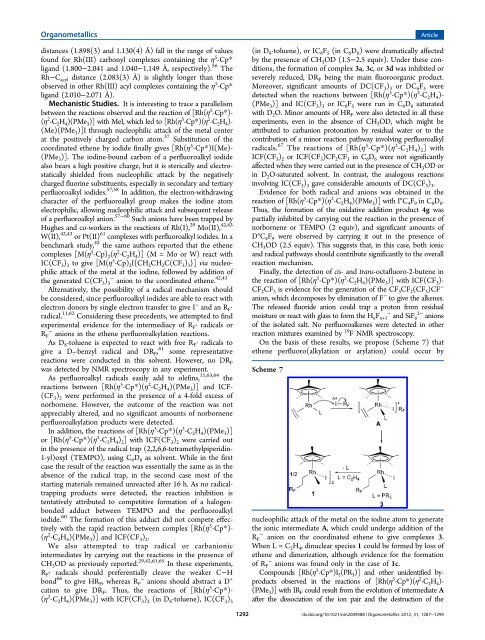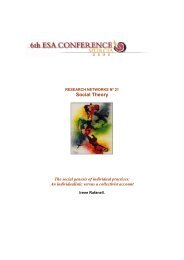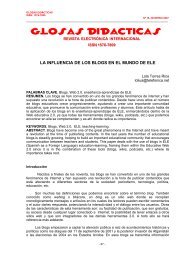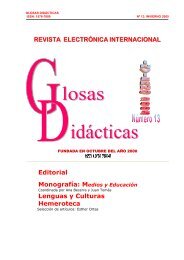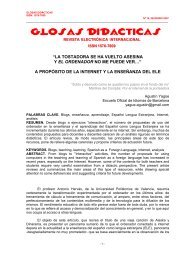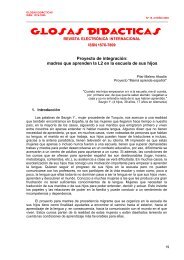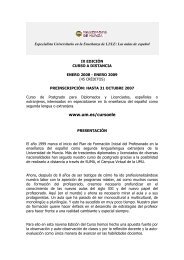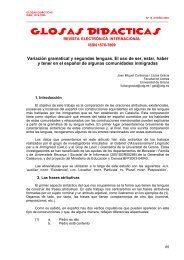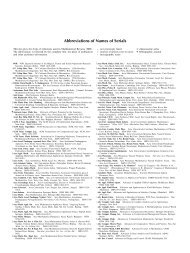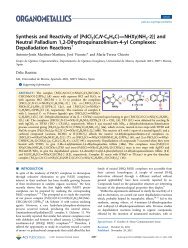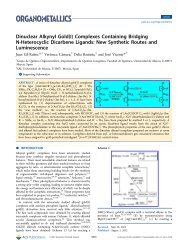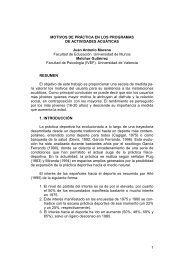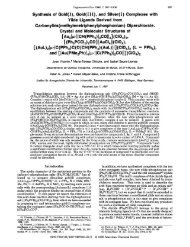Reactions of Half-Sandwich Ethene Complexes of Rhodium(I ...
Reactions of Half-Sandwich Ethene Complexes of Rhodium(I ...
Reactions of Half-Sandwich Ethene Complexes of Rhodium(I ...
You also want an ePaper? Increase the reach of your titles
YUMPU automatically turns print PDFs into web optimized ePapers that Google loves.
Organometallics<br />
Article<br />
(in D -toluene), or IC F (in C D ) were dramatically affected<br />
distances (1.898(3) and 1.130(4) Å) fall in the range <strong>of</strong> values<br />
found for Rh(III) carbonyl complexes containing the η 5 -Cp*<br />
ligand (1.800−2.041 and 1.040−1.149 Å, respectively). 56 The<br />
Rh−C acyl distance (2.083(3) Å) is slightly longer than those<br />
observed in other Rh(III) acyl complexes containing the η 5 -Cp*<br />
ligand (2.010−2.071 Å).<br />
Mechanistic Studies. It is interesting to trace a parallelism<br />
between the reactions observed and the reaction <strong>of</strong> [Rh(η 5 -Cp*)-<br />
(η 2 -C 2 H 4 )(PMe 3 )] with MeI, which led to [Rh(η 5 -Cp*)(η 2 -C 2 H 4 )-<br />
(Me)(PMe 3 )]I through nucleophilic attack <strong>of</strong> the metal center<br />
at the positively charged carbon atom. 37 Substitution <strong>of</strong> the<br />
coordinated ethene by iodide finally gives [Rh(η 5 -Cp*)I(Me)-<br />
(PMe 3 )]. The iodine-bound carbon <strong>of</strong> a perfluoroalkyl iodide<br />
also bears a high positive charge, but it is sterically and electrostatically<br />
shielded from nucleophilic attack by the negatively<br />
charged fluorine substituents, especially in secondary and tertiary<br />
perfluoroalkyl iodides. 57,58 In addition, the electron-withdrawing<br />
character <strong>of</strong> the perfluoroalkyl group makes the iodine atom<br />
electrophilic, allowing nucleophilic attack and subsequent release<br />
<strong>of</strong> a perfluoroalkyl anion. 57−60 Such anions have been trapped by<br />
Hughes and co-workers in the reactions <strong>of</strong> Rh(I), 29 Mo(II), 42,43<br />
W(II), 42,43 or Pt(II) 61 complexes with perfluoroalkyl iodides. In a<br />
benchmark study, 42 the same authors reported that the ethene<br />
complexes [M(η 5 -Cp) 2 (η 2 -C 2 H 4 )] (M = Mo or W) react with<br />
IC(CF 3 ) 3 to give [M(η 5 -Cp) 2 I{CH 2 CH 2 C(CF 3 ) 3 }] via nucleophilic<br />
attack <strong>of</strong> the metal at the iodine, followed by addition <strong>of</strong><br />
the generated C(CF 3 ) − 3 anion to the coordinated ethene. 42,43<br />
Alternatively, the possibility <strong>of</strong> a radical mechanism should<br />
be considered, since perfluoroalkyl iodides are able to react with<br />
electron donors by single electron transfer to give I − and an R F·<br />
radical. 11,62 Considering these precedents, we attempted to find<br />
experimental evidence for the intermediacy <strong>of</strong> R F· radicals or<br />
R − F anions in the ethene perfluoroalkylation reactions.<br />
As D 8 -toluene is expected to react with free R F· radicals to<br />
give a D 7 -benzyl radical and DR F , 61 some representative<br />
reactions were conducted in this solvent. However, no DR F<br />
was detected by NMR spectroscopy in any experiment.<br />
As perfluoroalkyl radicals easily add to olefins, 11,63,64 the<br />
reactions between [Rh(η 5 -Cp*)(η 2 -C 2 H 4 )(PMe 3 )] and ICF-<br />
(CF 3 ) 2 were performed in the presence <strong>of</strong> a 4-fold excess <strong>of</strong><br />
norbornene. However, the outcome <strong>of</strong> the reaction was not<br />
appreciably altered, and no significant amounts <strong>of</strong> norbornene<br />
perfluoroalkylation products were detected.<br />
In addition, the reactions <strong>of</strong> [Rh(η 5 -Cp*)(η 2 -C 2 H 4 )(PMe 3 )]<br />
or [Rh(η 5 -Cp*)(η 2 -C 2 H 4 ) 2 ] with ICF(CF 3 ) 2 were carried out<br />
in the presence <strong>of</strong> the radical trap (2,2,6,6-tetramethylpiperidin-<br />
1-yl)oxyl (TEMPO), using C 6 D 6 as solvent. While in the first<br />
case the result <strong>of</strong> the reaction was essentially the same as in the<br />
absence <strong>of</strong> the radical trap, in the second case most <strong>of</strong> the<br />
starting materials remained unreacted after 16 h. As no radicaltrapping<br />
products were detected, the reaction inhibition is<br />
tentatively attributed to competitive formation <strong>of</strong> a halogenbonded<br />
adduct between TEMPO and the perfluoroalkyl<br />
iodide. 60 The formation <strong>of</strong> this adduct did not compete effectively<br />
with the rapid reaction between complex [Rh(η 5 -Cp*)-<br />
(η 2 -C 2 H 4 )(PMe 3 )] and ICF(CF 3 ) 2 .<br />
We also attempted to trap radical or carbanionic<br />
intermediates by carrying out the reactions in the presence <strong>of</strong><br />
CH 3 OD as previously reported. 29,42,61,65 In these experiments,<br />
R F· radicals should preferentially cleave the weaker C−H<br />
bond 66 to give HR F , whereas R − F anions should abstract a D +<br />
cation to give DR F . Thus, the reactions <strong>of</strong> [Rh(η 5 -Cp*)-<br />
(η 2 -C 2 H 4 )(PMe 3 )] with ICF(CF 3 ) 2 (in D 8 -toluene), IC(CF 3 ) 3<br />
8 6 5 6 6<br />
by the presence <strong>of</strong> CH 3 OD (1.5−2.5 equiv). Under these conditions,<br />
the formation <strong>of</strong> complex 3a, 3c, or3d was inhibited or<br />
severely reduced, DR F being the main fluoroorganic product.<br />
Moreover, significant amounts <strong>of</strong> DC(CF 3 ) 3 or DC 6 F 5 were<br />
detected when the reactions between [Rh(η 5 -Cp*)(η 2 -C 2 H 4 )-<br />
(PMe 3 )] and IC(CF 3 ) 3 or IC 6 F 5 were run in C 6 D 6 saturated<br />
with D 2 O. Minor amounts <strong>of</strong> HR F were also detected in all these<br />
experiments, even in the absence <strong>of</strong> CH 3 OD, which might be<br />
attributed to carbanion protonation by residual water or to the<br />
contribution <strong>of</strong> a minor reaction pathway involving perfluoroalkyl<br />
radicals. 67 The reactions <strong>of</strong> [Rh(η 5 -Cp*)(η 2 -C 2 H 4 ) 2 ]with<br />
ICF(CF 3 ) 2 or ICF(CF 3 )CF 2 CF 3 in C 6 D 6 were not significantly<br />
affected when they were carried out in the presence <strong>of</strong> CH 3 OD or<br />
in D 2 O-saturated solvent. In contrast, the analogous reactions<br />
involving IC(CF 3 ) 3 gave considerable amounts <strong>of</strong> DC(CF 3 ) 3 .<br />
Evidence for both radical and anions was obtained in the<br />
reaction <strong>of</strong> [Rh(η 5 -Cp*)(η 2 -C 2 H 4 )(PMe 3 )] with I n C 4 F 9 in C 6 D 6 .<br />
Thus, the formation <strong>of</strong> the oxidative addition product 4g was<br />
partially inhibited by carrying out the reaction in the presence <strong>of</strong><br />
norbornene or TEMPO (2 equiv), and significant amounts <strong>of</strong><br />
D n C 4 F 9 were observed by carrying it out in the presence <strong>of</strong><br />
CH 3 OD (2.5 equiv). This suggests that, in this case, both ionic<br />
and radical pathways should contribute significantly to the overall<br />
reaction mechanism.<br />
Finally, the detection <strong>of</strong> cis- and trans-octafluoro-2-butene in<br />
the reaction <strong>of</strong> [Rh(η 5 -Cp*)(η 2 -C 2 H 4 )(PMe 3 )] with ICF(CF 3 )-<br />
CF 2 CF 3 is evidence for the generation <strong>of</strong> the CF 3 CF 2 (CF 3 )CF −<br />
anion, which decomposes by elimination <strong>of</strong> F − to give the alkenes.<br />
The released fluoride anion could trap a proton from residual<br />
moisture or react with glass to form the H n F − n+1 and SiF 2− 6 anions<br />
<strong>of</strong> the isolated salt. No perfluoroalkenes were detected in other<br />
reaction mixtures examined by 19 F NMR spectroscopy.<br />
On the basis <strong>of</strong> these results, we propose (Scheme 7) that<br />
ethene perfluoro(alkylation or arylation) could occur by<br />
Scheme 7<br />
nucleophilic attack <strong>of</strong> the metal on the iodine atom to generate<br />
the ionic intermediate A, which could undergo addition <strong>of</strong> the<br />
R − F anion on the coordinated ethene to give complexes 3.<br />
When L = C 2 H 4 , dinuclear species 1 could be formed by loss <strong>of</strong><br />
ethene and dimerization, although evidence for the formation<br />
<strong>of</strong> R − F anions was found only in the case <strong>of</strong> 1c.<br />
Compounds [Rh(η 5 -Cp*)I 2 (PR 3 )] and other unidentified byproducts<br />
observed in the reactions <strong>of</strong> [Rh(η 5 -Cp*)(η 2 -C 2 H 4 )-<br />
(PMe 3 )] with IR F could result from the evolution <strong>of</strong> intermediate A<br />
after the dissociation <strong>of</strong> the ion pair and the destruction <strong>of</strong> the<br />
1292<br />
dx.doi.org/10.1021/om2009588 | Organometallics 2012, 31, 1287−1299


